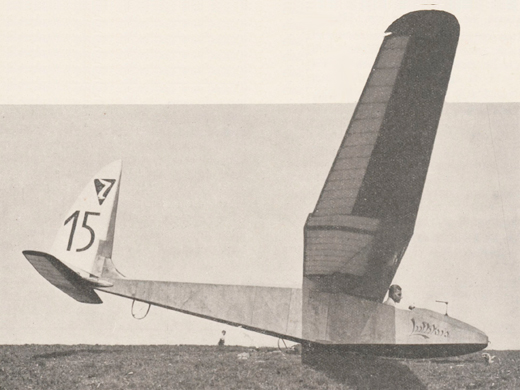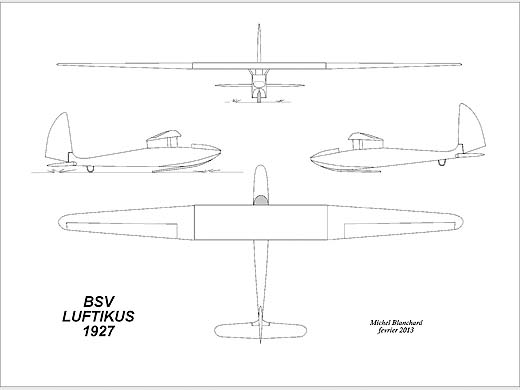
BSV Luftikus
Autre nom (ou nom en langue originelle) : Berliner Luftikus| DONNÉES GÉNÉRALES |
| Année du premier vol (ou de design, si seul projet) |
1927 |
| Pays | Allemagne |
| Designer(s) | HOHMUTH, Otto |
| Premier constructeur | B.S.V. (Berliner Segelflugverein eV.), Berlin (DE) |
| Type d'appareil | Planeur |
| Fonction | Performance |
| SPÉCIFICATIONS TECHNIQUES |
| Envergure | 15 m |
| Longueur | 6.4 m |
| Hauteur | 1.8 m |
| Allongement | 14.6 |
| Surface alaire | 15.4 m2 |
| Profil aile | Göttingen 535 |
| Masse à vide | 143 kg |
| Masse maxi | 214 kg |
| Charge alaire | 13.9 kg/m2 |
| Vitesse mini | -- |
| Vitesse maxi | -- |
| Finesse maxi | |
| Taux de chute mini | 0.74 m/s à 50 km/h |
| Nb sièges | 1 |
| Structure | Bois et toile |
AUTRES INFORMATIONS
| Constructeur(s) |
| ||||||
| Infos techniques | La forme générale de l'appareil est assez semblable à celle « Vampyr » avec des lignes améliorées et plus fines. L'aile est en trois parties et de construction simple, avec une partie centrale droite et des parties extérieures trapézoïdales. Un longeron supplémentaire, partant du point de poussée vers l'arrière, renforce la partie centrale. L'aile repose sur une saillie droite et un peu haute par rapport au fuselage et est soutenue à une courte distance de celle-ci par deux courtes entretoises creuses en acier, qui sont fixées au bord supérieur du fuselage. La carrosserie est recouverte de contreplaqué et présente une section hexagonale à l'avant et rectangulaire à l'arrière, comme celle du « Vampyr ». La plus grande largeur de la carrosserie, 0,48 mètre au niveau du pilote, est étonnamment étroite, de sorte qu'au cours d'un long vol, le pilote ne dispose que d'une faible liberté de mouvement. La carrosserie se termine à l'arrière par une arête horizontale, élargie par un petit aileron stabilisateur horizontal. Le gouvernail de direction, haut et pointu, était fixé à une petite dérive fixe sur l'extrados du corps, devant le mécanisme de commande de la gouverne de profondeur. En fait, cette disposition des commandes était autrefois la norme. Les gouvernes étaient extraordinairement légères, mais en même temps solidement construites. | ||||||
| Histoire résumée | Ce planeur a été dessiné et construit par O. HOHMUTH, président du BSV (Berliner Segelflug-Verein e.V., association berlinoise de vol à voile), aidé par les membres du club. Il a participé au concours de la Rhön à la Wasserkuppe de 1929 à 1932 avec le numéro 15, et en 1933, avec le numéro 42. En dépit de ses formes très anguleuses, ce planeur surpassait la plupart des autres machines de performance de l'époque, et permit à son jeune pilote Otto BEDAU d'obtenir son brevet C dès le début du concours de la Rhön 1929. | ||||||
| Liens personnalités | Pas de personnalité associée. | ||||||
| Compléments docs |
SOURCES DOCUMENTAIRES
| Liens WEB | Site : E-pics, ETH Zürich . Une photo. Le Luftikus en vol à la Wasserkuppe. (2012-07-07 CL) |
| Livres | Historische Deutsche Flugzeuge bis 1945 par KENS, Karlheinz (2004) [p. 50-57. Texte + 13 photos + 2 plan 3 vues + specs]. Wunder des Segelfluges par SPIEGEL, Wilhelm (1935) [Photo (Rhön 1930)]. |
| Autres sources | The Rhön competitions, par J.R. Ashwell-Cooke, Flight 5 septembre 1930. Flight 19 septembre 1930 (une photo) et Flight 30 octobre 1931 (mention). Technical report of the Rhön glider meeting 1929, par A. Lippisch, Wasserkuppe, Rhön, The British Gliding Association Journal vol. 1 n° 3, janvier 1931 p 66-82. Publié in "Zeitschrift fiir Flugtechnik und Motorluftschriffahrt," volume 21, No. 4, p. 92 ; editeur R. Oldenbourg, Munich. Texte + photo + plan 3 vues + specs. L'Aérophile No 4, 15 avril 1931 p.114, photo + specs |

MODÈLES RÉDUITS
|
 Fiche n° 2055 [Dernière mise à jour : 2025-02-16]
Fiche n° 2055 [Dernière mise à jour : 2025-02-16]
Team J2mcL © 2003 -
- Pages optimisées pour Mozilla Firefox

